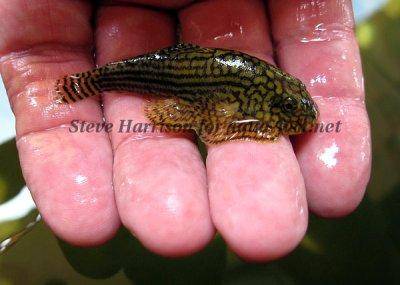Tiger hillstream loach - Sewellia lineolata
Scientific name: Sewellia lineolata
Common name: Tiger hillstream loach
Family: Balitoridae
Usual size in fish tanks: 9 - 11 cm (3.54 - 4.33 inch)
014
Recommended pH range: 6 - 7
Recommended water hardness: 4 - 10°N (71.43 - 178.57ppm)
0°C 32°F30°C 86°F
Recommended temperature range: 23 - 26 °C (73.4 - 78.8°F)
The way how these fish reproduce: Spawning
Where the species comes from: South Asia
Temperament to its own species: peaceful
Temperament toward other fish species: peaceful
Usual place in the tank: Bottom levels
Origin
The Hillstream loach is native exclusively to the waterways of Vietnam.
Lifespan
When properly cared for, the Hillstream loach has a lifespan of 5-10 years.
Short Description
This striking little fish is an excellent addition as a bottom-dweller in any aquarium. Often referred to as the Vietnamese loach, it is typically available for purchase at reasonable prices.
Since they come from fast-flowing waters with high oxygen levels, it’s essential to replicate these conditions in the aquarium. Adjusting filter outlets to increase surface agitation enhances gas exchange. You can also use powerheads to create the strong water currents these fish thrive in. For substrate, opt for sand or small, smooth gravel to prevent injuries.
Hillstream loaches should be introduced only into fully cycled tanks with some established algae growth to provide them with a steady food source. Strong lighting will promote algae growth, which is crucial for their long-term health. A lack of algae can lead to malnutrition in these fish.
Regular water changes are vital for maintaining optimal water quality. Additionally, ensure the tank has a tight-fitting lid, as these loaches are known for being excellent escape artists.
While the Hillstream loach is peaceful towards mid-level swimmers, avoid housing them with other bottom-dwellers, as competition for food can lead to territorial disputes.
Feeding
The Hillstream loach thrives on algae, which forms a crucial part of its diet, so it’s important not to maintain an overly clean aquarium if you’re keeping these fish. Adding plants can help stimulate additional algal growth on the leaves, offering a steady food source. Supplement their diet with vegetables like chopped spinach, spirulina flakes, and other plant-based foods, especially if natural algae levels are insufficient.
When purchasing these loaches, ensure they are active and check for sunken bellies, as this is a clear indicator of malnutrition.
Sexing
In mature Hillstream loaches, males generally have a slimmer body than females and may develop small growths, known as tubercles, on their heads.
Breeding
Breeding the Hillstream loach has been successfully achieved with the right setup. Use an air-driven sponge filter to maintain excellent water quality, and opt for a gravel substrate in the breeding tank. A slight increase in water temperature can trigger spawning. The male will court the female, leading to a display where they intertwine in the water column, releasing eggs and milt. The eggs will settle at the bottom, hatching after a few days. Once the fry are free-swimming, start feeding them Infusoria until they’re large enough to eat other foods.
Thanks to Martin Thoene for telling us the correct latin name.












 Chinese
Chinese